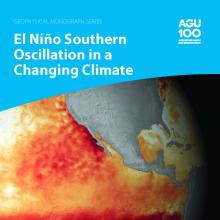El Niño Southern Oscillation in a Changing Climate
The El Niño Southern Oscillation (ENSO) in the Pacific Ocean has major worldwide social and economic consequences through its global scale effects on atmospheric and oceanic circulation, marine and terrestrial ecosystems, and other natural systems. It is the most dramatic year-to-year variation of the Earth’s climate system, affecting agriculture, public health, freshwater availability, power generation, and economic activity in the United States and around the globe. Ongoing climate change is projected to significantly alter ENSO’s dynamics and impacts.

Satellite sea surface temperature departure for October 2015 over the Pacific. Orange-red colors indicate above normal temperatures, indicative of an El Niño condition. The 2015-16 El Niño was the first extreme El Niño of the 21st century and among the three strongest El Niños on record. Credit: NOAA National Environmental Satellite, Data, and Information Service (NESDIS)


